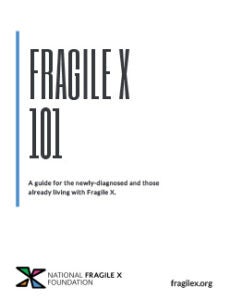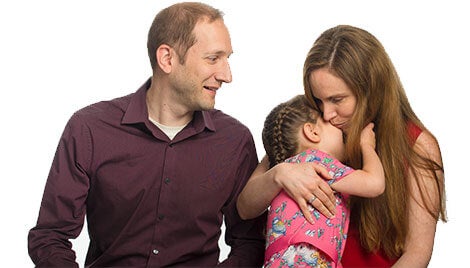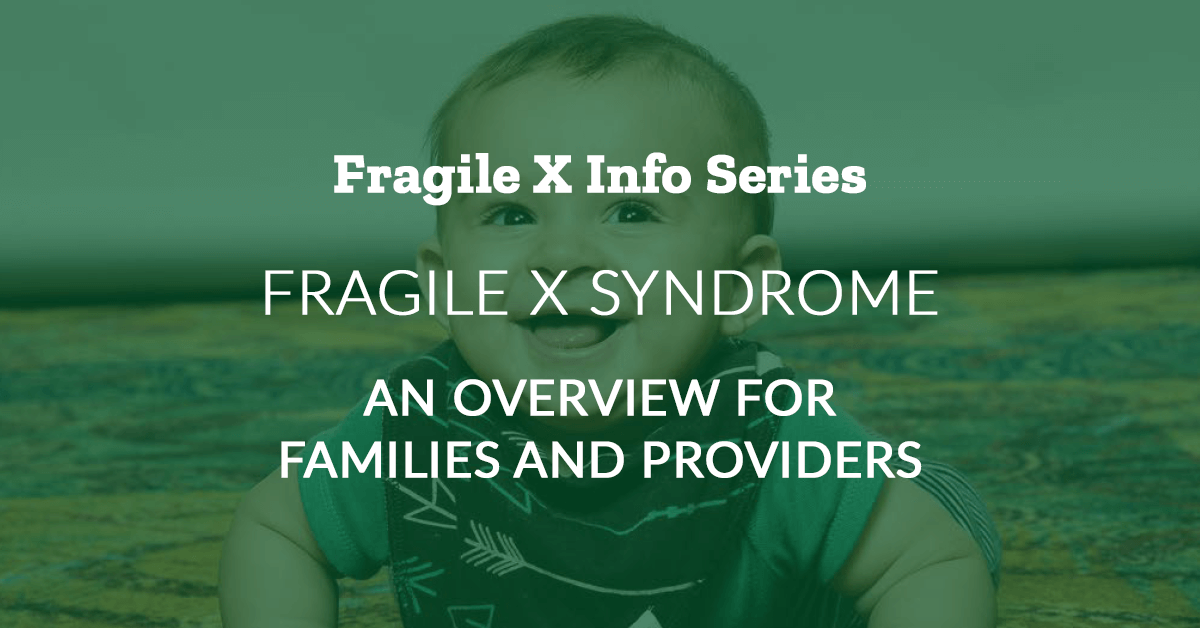Fragile X 101
What is Fragile X Syndrome?
Fragile X syndrome (FXS) is caused by a mutation of a single gene — FMR1 — on the X chromosome and is inherited genetically, often unknowingly. Everyone has the FMR1 gene on their X chromosome, but when a mutation occurs, it can cause intellectual disability, behavioral and learning challenges, and various physical characteristics. There is no cure, but therapies, interventions, and medications are often prescribed to treat behavioral symptoms like anxiety, aggression, and ADHD.
FRAGILE X 101
A Guide for the Newly Diagnosed and Those Already Living with Fragile X
This guide helps answer questions about common physical, cognitive, and behavioral issues. You’ll also learn how Fragile X is inherited, the various treatment options available, how females are affected vs. males, and the support you can receive from the NFXF.

Female carriers have a 50% chance of passing the mutation to each of her children, while males will pass it to all of his daughters (and and none of his sons).
Though Fragile X syndrome occurs in both genders, males are more frequently affected than females, and generally with greater severity. In fact, some females may not experience any of the behavioral, cognitive, or physical features that appear more widely in males.
Exactly why males are more often and more severely affected is unknown. But it’s believed to be due to the fact that females have two X chromosomes and males have only one — can a damaged FMR1 gene on one X chromosome be compensated for by a healthy FMR1 gene on the other? Because males have only one X, if they receive a damaged FMR1 gene, it’s the only one they have.
Life Expectancy
The life span for people with FXS is not affected because there are usually no life-threatening health concerns associated with the condition.
Prevalence
There have been a number of studies aimed at determining the prevalence of FXS in males and females. Studies have been undertaken both in the “special needs” population and the general population. The agreed upon prevalence of FXS:
- Males — approximately 1 in 4,000 to 1 in 7,000
- Females — approximately 1 in 6,000 to 1 in 11,000
Signs & Symptoms
In Males
Physical features
No one individual will have all the features of FXS, and some features, such as a long face and macroorchidism, are more common after puberty. Some of the features are due to poor connective tissue, such as flexible joints, flat feet, and high arched palate.
Physical features may include:
- Large ears
- Long face
- Soft skin
- Flexible joints — particularly fingers, wrists, elbows
- Low muscle tone
- Flat feet
- High arched palate
- Large testicles (called “macroorchidism”) in post-pubertal males
Behavioral characteristics
Behavioral characteristics may include:
- Sensory processing challenges (sensitive fabrics or clothing, loud noises, crowds, food textures, etc.)
- Hand-flapping, hand-biting
- Poor eye contact
- ADHD (attention deficit/hyperactive disorder)
- Anxiety
- Autism spectrum disorders
- Increased risk for aggression
- Sleep disorders
Cognitive Abilities
- Cognitive abilities in FXS include a range from mild learning disabilities to more severe intellectual disabilities. The majority of males with Fragile X syndrome demonstrate moderate intellectual disability.
- Speech and language delay
- Motor delay (late crawling, walking, toileting)
Medical Issues
Medical issues may include:
- Ear infections (also often due to poor connective tissue)
- Strabismus (crossed eyes)
- Seizures
Disposition
Disposition characteristics often include:
- Very social and friendly
- Excellent imitation skills
- Strong visual and long-term memory
- Especially nice, likes to help others
- Wonderful sense of humor
In Females
Behavioral characteristics
Behavioral characteristics seen in males can also be seen in females, though females often have a milder presentation of the syndrome’s behavioral, physical, and connective tissue features.
Cognitive Abilities
About one-third of females with FXS have no to very mild learning disabilities, about a third have mild learning disabilities, and a third have moderate to significant intellectual disabilities.
Additional issues sometimes seen are:
- Emotional and mental health issues
- General anxiety
- Social anxiety
A small percentage of females who have the full mutation of the FMR1 gene that causes FXS will have no apparent signs of the condition — intellectual, behavioral, or physical. These females are often identified only after another family member has been diagnosed.
The 3 Main Fragile X Disorders
Full mutation of the FMR1 gene (> 200 CGG repeats)
1. Fragile X Syndrome
Symptoms include intellectual disability, behavioral and learning challenges, and various physical characteristics. Males are more frequently affected, and generally with greater severity.
Premutation of the FMR1 gene (55–200 CGG repeats)
Traditionally, a carrier of a genetic mutation is defined as a person who inherits an altered form of a gene but shows no effects of that mutation. However, in Fragile X this definition does not exactly fit as carriers of a Fragile X premutation are at risk to develop FXTAS and FXPOI.
2. FXTAS — Fragile X-Associated Tremor/Ataxia Syndrome
Premutation carriers of an FMR1 gene mutation can have no apparent signs of a Fragile X disorder, and may or may not develop FXTAS (pronounced: FAKS-taz), which usually occurs in male premutation carriers after age 50, with symptoms — including balance, tremor, and memory problems — worsening with age.
LEARN MORE
3. FXPOI — Fragile X-Associated Primary Ovarian Insufficiency
Premutation carriers of an FMR1 gene mutation can have no apparent signs of a Fragile X disorder, and may or may not develop FXPOI (pronounced: FAKS-poi), which usually occurs in female premutation carriers after age 40, and refers to a spectrum of impaired ovarian functions that can include infertility and early menopause.
LEARN MORE
Genetics & Inheritance
Fragile X-associated disorders include a wide range of physical, intellectual, and behavioral symptoms that can affect family members in many different ways. These conditions are passed down in families through expansions of the FMR1 gene. Even for genetics professionals, FMR1 inheritance is complex and confusing, so it’s no surprise that families often have questions about the genetics of Fragile X. We start with some background on genetics and chromosomes …
Testing & Diagnosis
Who should be tested, lab tests for Fragile X including testing costs and reporting time, and other tests for children with developmental delay.
Premutation Carriers
When you or a family member are told you are a “carrier” for a Fragile X mutation, many questions arise.
More from the Fragile X Info Series
Fragile X Info Series flyers are designed to be easily printable on home and office printers. We created them so you can distribute them as needed, whether it’s for a neighbor, students at school, your own reference, or you work at a clinic and want to share information with new families. Whatever the cause, they are meant to be informative and shareable.
Questions?
If you’re a parent or caregiver and have questions about the information presented here, we’d love to hear from you! You can reach out to Missy Zolecki using the contact info or our contact form below.

Missy Zolecki,
Community Empowerment
treatment@fragilex.org
(800) 688-8765










